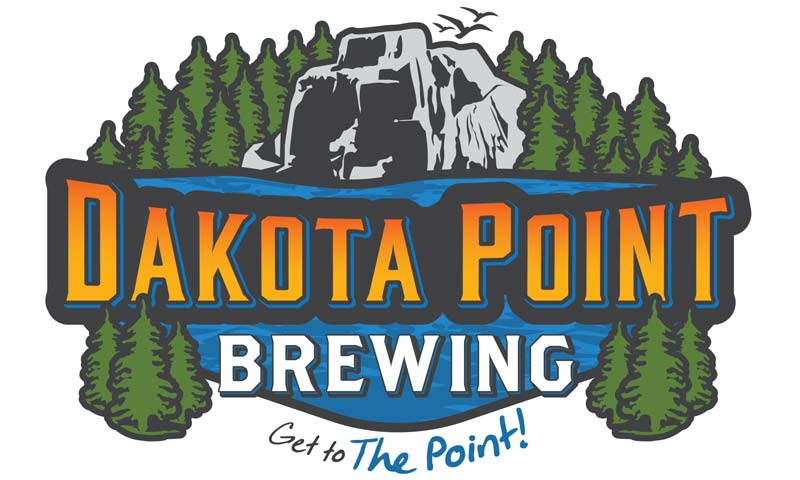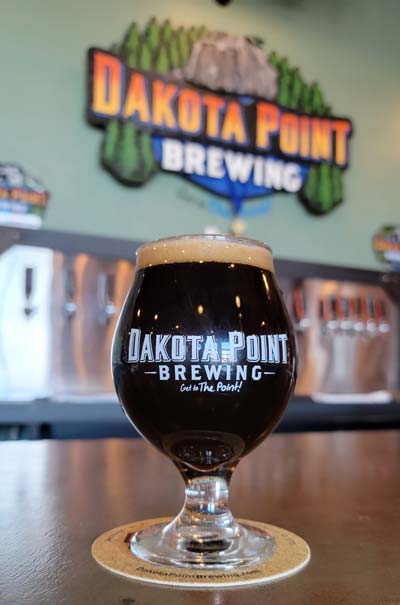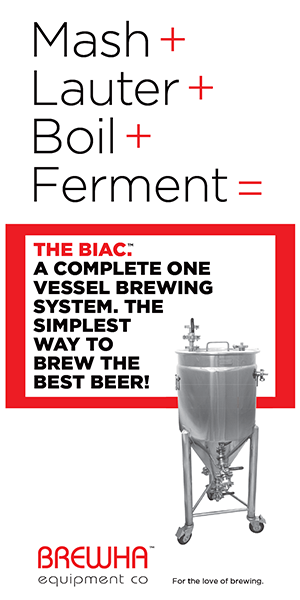Dakota Point Brewing
Dear Replicator,
During a recent trip to the Black Hills, my family and I stopped by Dakota Point Brewing in Rapid City, South Dakota. One of the first things I noticed upon entering the brewery was a tin sign for Two Track Malting, a craft malting company from Lincoln, North Dakota, very near where we live and also the supplier of the base malt I use for the majority of the beer I brew. Dakota Point Brewing’s French toast-themed pastry stout, Antoinette’s Antidote, really impressed my wife and me. I’m hopeful you’ll be able to dig up the specifics behind their delicious pastry stout
Scott Vogel
Bismarck, North Dakota
Beer is known as the great social lubricant, a tried-and-true means of easing people into new social situations and making conversation flow. Throughout all of history, beer has been the great unifier behind much of human culture — and that’s just as true of brewery owners as well as craft beer drinkers. Like so many others, Dakota Point Brewing, located in Rapid City, was born out of friendship and a lot of time enjoying beers in good company.
Opened in June 2018 by three longtime friends, Neal Schlottman, Jim Boulter, and Dave Eddy, the idea for Dakota Point was hatched while gathered around a campfire in the Black Hills region. Dave Eddy had been a homebrewer for nearly a decade and eventually began to follow the path of many a passionate amateur brewer, contemplating and planning how to share his hobby with a larger audience.

For the three high school friends, beer and stories went hand in hand. A brewery, they realized, was always going to be at its best when it served as a hub for its local community. With a booming beer scene, Rapid City seemed an ideal location for their project. In an area rich in history and spoiled with vast, dramatic western landscapes, the owners quickly saw the appeal of uniting their neighbors around the sort of shared drinking experiences they had so often enjoyed together.
“We wanted to create a place where people can have a similar experience by meeting friends, family, or others in the community for a great craft beer,” said Schlottman.
With this goal in mind, the team of friends selected a location close to downtown Rapid City so that the brewery could serve as many members of the community as possible. The building they selected for the site was an old power generation plant, providing history and atmosphere as well as plenty of space for the brewery’s 7-bbl brewhouse and cask system for serving English pub-style beers.
According to Schlottman, the owners and brewers enjoy all varieties of beer, and thus try not to place too much focus on any one style. Every kind of beer, Schlottman believes, deserves an opportunity to land on the taplist. The owners felt that many older styles have begun to fall to the wayside in recent years, however. Classic English, Irish, and Scottish styles in particular no longer receive the same amount of attention they once did, and yet these are the very styles that work so well in a hand-pumped cask.
Cask beer has been an important factor in setting Dakota Point apart from other breweries in the region, according to Schlottman, helping to round out their comprehensive taplist while adding an engaging, atmospheric element to the taproom. Dakota Point serves their cask beers at a precise 48 °F (9 °C) to ensure the full spectrum of flavor is on display, and selects beers that offer an appropriately nuanced profile. Sometimes that means a simple, classic style — but sometimes it’s a bold, flavor-packed experimental beer that hits the spot, too.
Dakota Point’s popular Antoinette’s Antidote French toast pastry stout was born out of the brewery’s open-mindedness toward all beer styles. “A local pub was always talking about pastry stouts and hounding us to make one,” Schlottman said. “We envisioned the beer being big, dark, thick, over the top, and sweet . . . like French toast. Finally, one day, we just had to give in.”
The brewing team wanted to maximize all that the style had to offer, and so they attempted to balance out dark and roasty malts with a rich, dextrinous wort and the addition of lactose and brown sugar. The base beer thus holds up well to a higher alcohol content and new flavor varieties. By creating tinctures with the various flavoring spices in advance, Dakota Point is able to create different treatments for each half barrel. With this method, the brewery has been able to test out multiple donut-, pastry-, and coffee-inspired variants. So far, however, their French toast-inspired stout has proven to be the biggest hit with their patrons, with repeated requests for more coming from both locals and tourists alike.
By now, the brewery has riffed on a number of different breakfast and desert classics, like tiramisu, blueberry crunch, Bavarian cream, and even turtle candy. For several of these iterations, Dakota Point teamed up with a local bakery to use real donuts in the mash — a fun way of introducing both extra sugars and more intense flavors. Homebrewers might consider doing the same, whether with French toast or another breakfast favorite. By utilizing tinctures to fine-tune the flavor profile of the final product, you’ll be able to get creative with the base recipe and still course-correct later, when dosing the tinctures.
Dakota Point Brewing’s Antoinette’s Antidote clone

(5 gallons/19 L, all-grain)
OG = 1.081 FG = 1.030
IBU = 33 SRM = 35 ABV = 6.7%
Ingredients
9 lbs. (4.1 kg) Maris Otter pale ale malt
12 oz. (0.34 kg) chocolate malt
12 oz. (0.34 kg) roasted barley
12 oz. (0.34 kg) flaked oats
5 oz. (142 g) crystal malt (60 °L)
8 oz. (0.23 kg) brown sugar
1.25 lbs. (0.57 kg) lactose sugar
1.25 lbs. (0.57 kg) extra light dried malt extract
1 tsp. cinnamon
1 tsp. nutmeg
1–2 Tbsp. vanilla extract
1–2 Tbsp. maple extract
9.2 AAU Magnum hops (60 min.) (0.75 oz./21 g at 12.3% alpha acids)
SafAle S-04, Wyeast 1098 (British Ale), or White Labs WLP007 (Dry English Ale) yeast
3⁄4 cup corn sugar (if priming)
Step by Step
For best results, create a spice tincture to add to the beer by taste. Combine cinnamon and nutmeg into an alcohol-based tincture, using either vodka or Bourbon. After allowing spices to soak for one to two weeks, strain using a coffee filter.
With the goal of creating a highly dextrinous wort, mash in with 3.3 gallons (12.5 L) of 168 °F (76 °C) strike water to achieve a single infusion rest temperature of 157 °F (69 °C). Hold at this temperature for 60 minutes.
With sparge water at 170 °F (77 °C), collect about 6 gallons (23 L) of wort. Add bittering hops, then boil for 60 minutes. At end of boil, carefully stir in the dried malt extract, lactose, and brown sugar.
After the boil (and optional whirlpool), rapidly chill the wort to slightly below fermentation temperature, around 66 °F (19 °C). Pitch yeast. If possible, allow fermentation temperature to rise gradually to around 70 °F (21 °C) toward the end of fermentation.
Before packaging, add a portion of the tincture in addition to vanilla extract and maple extract. Add incrementally, to taste. Bottle and prime with sugar or keg and force carbonate to 2.4 v/v.
Dakota Point Brewing’s Antoinette’s Antidote clone
(5 gallons/19 L, extract with grains)
OG = 1.081 FG = 1.030
IBU = 33 SRM = 35 ABV = 6.7%
Ingredients
6.6 lbs. (3 kg) extra light dried malt extract
12 oz. (0.34 kg) CaraFoam® malt
12 oz. (0.34 kg) chocolate malt
12 oz. (0.34 kg) roasted barley
5 oz. (142 g) crystal malt (60 °L)
8 oz. (0.23 kg) brown sugar
1.25 lbs. (0.57 kg) lactose sugar
1 tsp. cinnamon, ground
1 tsp. nutmeg, ground
1–2 Tbsp. vanilla extract
1–2 Tbsp. maple extract
9.2 AAU Magnum hops (60 min.) (0.75 oz./21 g at 12.3% alpha acids)
SafAle S-04, Wyeast 1098 (British Ale), or White Labs WLP007 (Dry English Ale) yeast
3⁄4 cup corn sugar (if priming)
Step by Step
For best results, create a spice tincture to add to the beer by taste. Combine cinnamon and nutmeg into an alcohol-based tincture, using either vodka or Bourbon. After allowing spices to soak for one to two weeks, strain using a coffee filter.
Steep the CaraFoam®, chocolate malt, roasted barley, and crystal malt in a muslin bag in 2 gallons (8 L) of water at 152 °F (67 °C) for 30 minutes. Afterwards, place the grain bag in a colander and wash with 1 gallon (4 L) of hot water. Add water to reach a total volume of 5 gallons (19 L). Carefully stir in the malt extract.
Add bittering hops, then boil for 60 minutes. At end of boil, add lactose and brown sugar.
After the boil (and optional whirlpool), rapidly chill the wort to slightly below fermentation temperature, around 66 °F (19 °C). Add cool water to fermenter to reach 5.25 gallons (20 L) then pitch yeast. If possible, allow fermentation temperature to rise gradually to around 70 °F (21 °C) toward the end of fermentation.
Before packaging, add a portion of the tincture in addition to vanilla extract and maple extract. Add incrementally, to taste. Bottle and prime with sugar or keg and force carbonate to 2.4 v/v.
Tips For Success:
Getting the spices dialed in is going to be one of the biggest challenges trying to recreate this beer. Using a 0.1-mL pipette (or eyedropper) to measure out the tincture and extract and a 1-oz. (28-mL) shot glass, will help you determine the best flavor combination. Then you’ll just need to scale up from one ounce to 5 gallons (19 L) or whatever batch size you produce.



